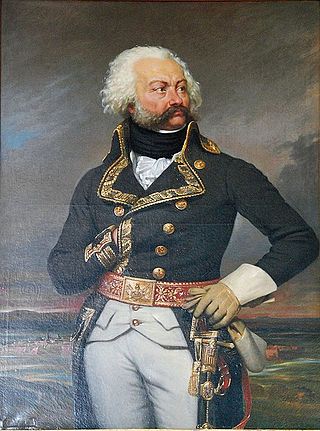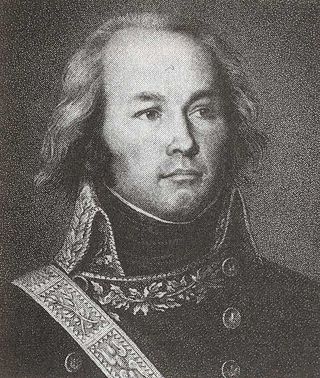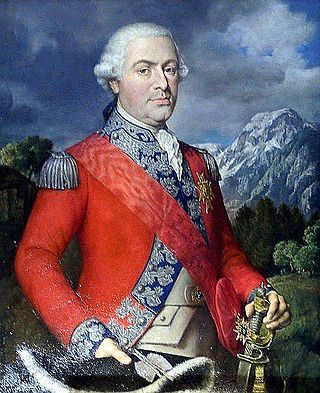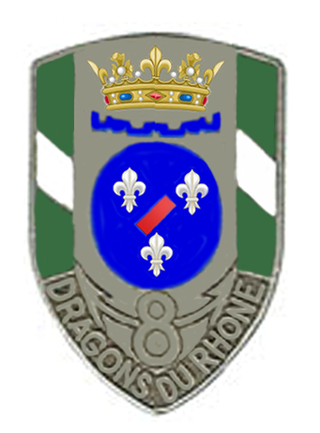
Jean-Jacques de Beausobre (Niort, 15 March 1704 - Bisseuil, 8 October 1783) was a Swiss military officer in French service.

Jean-Jacques de Beausobre (Niort, 15 March 1704 - Bisseuil, 8 October 1783) was a Swiss military officer in French service.
Originally from Morges, Beausobre was the son of Jeanne and Jean de Beausobre, a colonel in the French Régiment de Courten. [1] He entered his father's regiment as a cadet 1716. [1] Beausobre served with distinction in the War of the Polish Succession, the War of the Austrian Succession and the Seven Years' War. [1] Beausobre led the Siege of Geldern in 1757, during the Seven Years' War, and was appointed governor of Guelders until 1761. [1] He reached the rank of lieutenant-general in 1759. [1]

In 1743, Beausobre founded his own hussard regiment. He was made a marquis by King Louis XV in 1740. [1]

The House of Bourbon is a dynasty that originated in the Kingdom of France and is a branch of the Capetian dynasty, the royal House of France. Bourbon kings first ruled France and Navarre in the 16th century, and by the 18th century, members of the Spanish Bourbon dynasty held thrones in Spain, Naples, Sicily, and Parma. Today Spain and Luxembourg have monarchs of the House of Bourbon. The royal Bourbons originated in 1272, when Robert, the youngest son of King Louis IX of France, married the heiress of the lordship of Bourbon. The house continued for three centuries as a cadet branch, serving as nobles under the direct Capetian and Valois kings.

Adam Philippe, Comte de Custine was a French general. As a young officer in the French Royal Army, he served in the Seven Years' War. In the American Revolutionary War he joined Rochambeau's Expédition Particulière supporting the American colonists. Following the successful Virginia campaign and the Battle of Yorktown, he returned to France and rejoined his unit in the Royal Army.

This section of the Timeline of Quebec history concerns the events relating to the Quebec portion of New France between the establishment of the Sovereign Council and the fall of Quebec.

The Swiss mercenaries were a powerful infantry force constituted by professional soldiers originating from the cantons of the Old Swiss Confederacy. They were notable for their service in foreign armies, especially among the military forces of the kings of France, throughout the early modern period of European history, from the Late Middle Ages into the Renaissance. Their service as mercenaries was at its peak during the Renaissance, when their proven battlefield capabilities made them sought-after mercenary troops. There followed a period of decline, as technological and organizational advances counteracted the Swiss' advantages. Switzerland's military isolationism largely put an end to organized mercenary activity; the principal remnant of the practice is the Pontifical Swiss Guard at the Vatican.

Events from the year 1702 in Canada.

The French Army, officially known as the Land Army, is the principal land warfare force of France, and the largest component of the French Armed Forces; it is responsible to the Government of France, alongside the French Navy, French Air and Space Force, and the National Gendarmerie. The Army is commanded by the Chief of Staff of the French Army (CEMAT), who is subordinate of the Chief of the Defence Staff (CEMA), who commands active service Army units and in turn is responsible to the President of France. CEMAT is also directly responsible to the Ministry of the Armed Forces for administration, preparation, and equipment.

Baron Paul Kray of Krajova and Topolya, was a soldier, and general in Habsburg service during the Seven Years' War, the War of Bavarian Succession, the Austro–Turkish War (1787–1791), and the French Revolutionary Wars. He was born in Késmárk, Upper Hungary.

The Battle of Kallo was a major field battle fought from 20 to 21 June 1638 in and around the forts of Kallo and Verrebroek, located on the left bank of the Scheldt river, near Antwerp, during the second phase of the Eighty Years' War. Following the symbolic recovery of Breda during the 1637 campaign, the Dutch Republic agreed with the French Crown, with whom it had allied in 1635, to besiege a major city in the Spanish Netherlands during the 1638 campaign. The commander of the Dutch States Army, Frederick Henry of Orange, planned an approach over Antwerp from the two sides of the Scheldt. Count William of Nassau-Siegen was entrusted to land in the Spanish-controlled Waasland region, west of Antwerp, to seize the forts of Kallo and Verrebroek, along with several other key fortifications, to invest Antwerp from the west. In the meantime, Frederick Henry would advance on the opposite bank to complete the blockade of the city while the armies of France invaded the Spanish Netherlands from the south to oblige the Spanish Army of Flanders to divide its forces.

Augustine Prévost was a Genevan soldier best known for his service in the British Army during the Seven Years' War and the American War of Independence.

Jean Jacques Joseph d'Alt was a Swiss mercenary and administrator.

Claude Jacques Lecourbe was a French general during the French Revolutionary and Napoleonic wars.

Karl Joseph Anton Leodegar von Bachmann was a Swiss mercenary in French service, best known as the commander of the Swiss Guards during the Insurrection of 10 August 1792.

Fort Saint-Jean is a fort in the Canadian province of Quebec located on the Richelieu River. The fort was first built in 1666 by soldiers of the Carignan-Salières Regiment of France who had travelled to New France to assist the young colony. It was part of a series of forts built along the Richelieu River. Over the years, it was destroyed and rebuilt several times, but it is, after Quebec City, the military site that has been occupied non-stop for the longest time in Canada. The fort is designated as a National Historic Site of Canada, and it currently houses the Royal Military College Saint-Jean. The fort has been continually occupied since 1748, and is the core from which the city of Saint-Jean-sur-Richelieu, Quebec grew around. Fort Saint-Jean played a crucial role in the British defense strategy during the 1775 American invasion of the Province of Quebec.

The siege of Fort St Philip, also known as the siege of Minorca, took place from 20 April to 29 June 1756 during the Seven Years' War. Ceded to Great Britain in 1714 by Spain following the War of the Spanish Succession, its capture by France threatened the British naval position in the Western Mediterranean and it was returned after the Treaty of Paris (1763).
James Marcus or Mark Prevost was a British Army officer. After being commissioned in Europe, he commanded troops of the British Army in North America and the West Indies, including during the French and Indian War, the North American front of the Seven Years' War.

Friedrich Freiherr (Baron) von Hotze, was a Swiss-born general in the Austrian army during the French Revolutionary Wars. He campaigned in the Rhineland during the War of the First Coalition and in Switzerland in the War of the Second Coalition, notably at Battle of Winterthur in late May 1799, and the First Battle of Zurich in early June 1799. He was killed at the Battle of Linth River.
Jean Jacques Vioget (1794–1855), originally from Switzerland, was a surveyor and sea captain, who came to California in 1837. He made the first survey and map of Yerba Buena in 1839. He worked for John Sutter and later moved to San Jose. He was also an artist, violinist, and spoke multiple languages.

The French Royal Army was the principal land force of the Kingdom of France. It served the Bourbon dynasty from the reign of Louis XIV in the mid-17th century to that of Charles X in the 19th, with an interlude from 1792 to 1814 and another during the Hundred Days in 1815. It was permanently dissolved following the July Revolution in 1830. The French Royal Army became a model for the new regimental system that was to be imitated throughout Europe from the mid-17th century onward. It was regarded as Europe's greatest military force and the most powerful armies in the world for much of its existence.

For the 8th Dragoons in the British Army, see 8th King's Royal Irish Hussars.

Juan Courten y Gonzalez was a Spanish military officer. He began his career in the War of the Austrian Succession at the age of 14. Courten fought in the Spanish–Portuguese War (1761–1763), the Invasion of Algiers in 1775, and the Great Siege of Gibraltar. He was the last Spanish governor of Oran in 1792. As a lieutenant general, he led an infantry division during the War of the Pyrenees against the First French Republic in several actions including Perpignan, Peyrestortes, Truillas, Boulou, and the Black Mountain. He was appointed Captain General of Aragon in 1795.